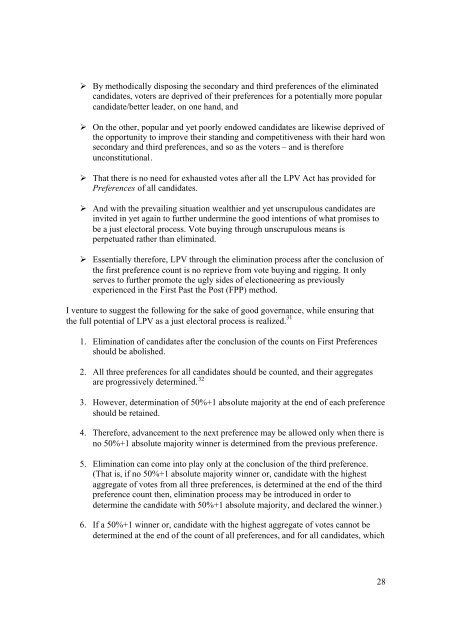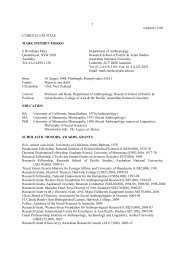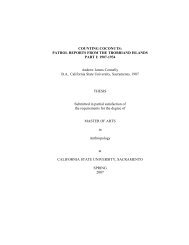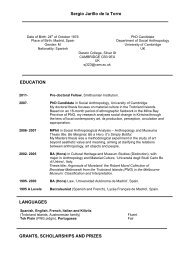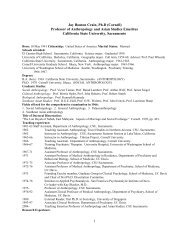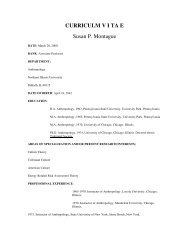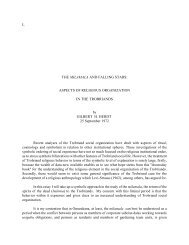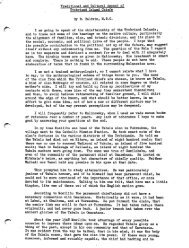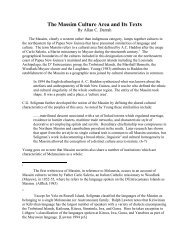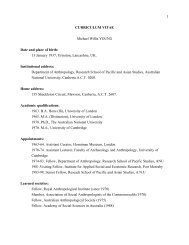Download a PDF of this paper - Trobriand Islands
Download a PDF of this paper - Trobriand Islands
Download a PDF of this paper - Trobriand Islands
You also want an ePaper? Increase the reach of your titles
YUMPU automatically turns print PDFs into web optimized ePapers that Google loves.
‣ By methodically disposing the secondary and third preferences <strong>of</strong> the eliminated<br />
candidates, voters are deprived <strong>of</strong> their preferences for a potentially more popular<br />
candidate/better leader, on one hand, and<br />
‣ On the other, popular and yet poorly endowed candidates are likewise deprived <strong>of</strong><br />
the opportunity to improve their standing and competitiveness with their hard won<br />
secondary and third preferences, and so as the voters – and is therefore<br />
unconstitutional.<br />
‣ That there is no need for exhausted votes after all the LPV Act has provided for<br />
Preferences <strong>of</strong> all candidates.<br />
‣ And with the prevailing situation wealthier and yet unscrupulous candidates are<br />
invited in yet again to further undermine the good intentions <strong>of</strong> what promises to<br />
be a just electoral process. Vote buying through unscrupulous means is<br />
perpetuated rather than eliminated.<br />
‣ Essentially therefore, LPV through the elimination process after the conclusion <strong>of</strong><br />
the first preference count is no reprieve from vote buying and rigging. It only<br />
serves to further promote the ugly sides <strong>of</strong> electioneering as previously<br />
experienced in the First Past the Post (FPP) method.<br />
I venture to suggest the following for the sake <strong>of</strong> good governance, while ensuring that<br />
the full potential <strong>of</strong> LPV as a just electoral process is realized. 31<br />
1. Elimination <strong>of</strong> candidates after the conclusion <strong>of</strong> the counts on First Preferences<br />
should be abolished.<br />
2. All three preferences for all candidates should be counted, and their aggregates<br />
are progressively determined. 32<br />
3. However, determination <strong>of</strong> 50%+1 absolute majority at the end <strong>of</strong> each preference<br />
should be retained.<br />
4. Therefore, advancement to the next preference may be allowed only when there is<br />
no 50%+1 absolute majority winner is determined from the previous preference.<br />
5. Elimination can come into play only at the conclusion <strong>of</strong> the third preference.<br />
(That is, if no 50%+1 absolute majority winner or, candidate with the highest<br />
aggregate <strong>of</strong> votes from all three preferences, is determined at the end <strong>of</strong> the third<br />
preference count then, elimination process may be introduced in order to<br />
determine the candidate with 50%+1 absolute majority, and declared the winner.)<br />
6. If a 50%+1 winner or, candidate with the highest aggregate <strong>of</strong> votes cannot be<br />
determined at the end <strong>of</strong> the count <strong>of</strong> all preferences, and for all candidates, which<br />
28


